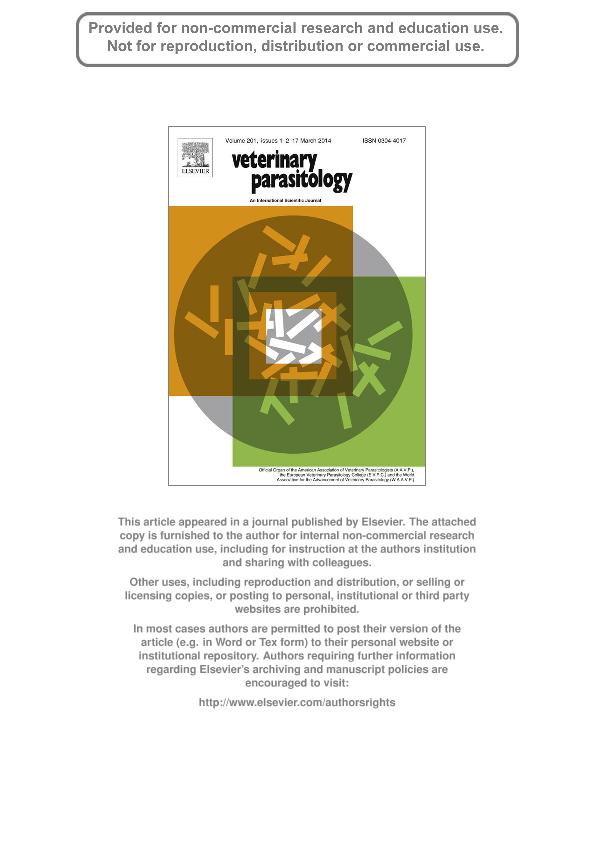Mostrar el registro sencillo del ítem
dc.contributor.author
Suárez, Gonzalo
dc.contributor.author
Alvarez, Luis Ignacio

dc.contributor.author
Casstells, Daniel
dc.contributor.author
Moreno Torrejon, Laura

dc.contributor.author
Faggiolino, Pietro
dc.contributor.author
Lanusse, Carlos Edmundo

dc.date.available
2018-01-17T16:59:40Z
dc.date.issued
2013-12
dc.identifier.citation
Alvarez, Luis Ignacio; Lanusse, Carlos Edmundo; Moreno Torrejon, Laura; Casstells, Daniel; Faggiolino, Pietro; Suárez, Gonzalo; et al.; Evaluation of pharmacological interactions after administration of a levamisole, albendazole and ivermectin triple combination in lambs; Elsevier Science; Veterinary Parasitology; 201; 1-2; 12-2013; 110-119
dc.identifier.issn
0304-4017
dc.identifier.uri
http://hdl.handle.net/11336/33620
dc.description.abstract
The goals of the current trial were (a) to characterize the plasma disposition kinetics of levamisole (LEV), albendazole (ABZ) and ivermectin (IVM), each administered either alone (single active ingredient) or as a combined formulation to lambs; (b) to compare the clinical anthelmintic efficacy of the same drugs given either separately or co-administered to lambs infected with resistant nematodes. Fifty Corriedale lambs naturally infected with multiple resistant gastrointestinal nematodes were involved in the following experimental trials: (a) “Pharmacokinetic trial”: the animals were allocated into five groups (n = 10 each) and intraruminally treated with either LEV (8 mg/kg), ABZ (5 mg/kg), IVM (0.2 mg/kg), or with a LEV + ABZ + IVM combined formulation, where each active ingredient was administered at the same dose. Blood samples were collected over 15 days post-treatment and drug plasma concentrations measured by HPLC. (b) “Efficacy trial”: the same treated groups plus an untreated control group were used to assess the comparative anthelmintic efficacy by the faecal egg count reduction test (FECRT). Although the overall LEV disposition kinetics was unaffected, significantly lower (61%) ABZ-sulphoxide and higher (71%) IVM systemic availabilities were obtained after administration of the combined formulation in comparison to those obtained after treatment with each drug alone. A multiple drug resistance situation was observed for Haemonchus spp. The observed efficacies were 52% (LEV), 72% (ABZ), 80% (IVM) and 87% (triple combined formulation). The results reported here contribute to the pharmaco-therapeutic knowledge on drug combinations. This type of research is crucial before further development of combined anthelmintic preparations reaches the market to deal with resistant nematode control. The co-administration of LEV + ABZ + IVM did not result in a significant advantageous anthelmintic effect compared to the treatment with IVM alone. The simultaneous/combined administration of LEV, ABZ and IVM may account for a drug–drug pharmacological interaction in infected lambs. The pharmacokinetic interaction accounted for a reduced ABZ-sulphoxide and enhanced IVM systemic exposure following the combined treatment.
dc.format
application/pdf
dc.language.iso
eng
dc.publisher
Elsevier Science

dc.rights
info:eu-repo/semantics/openAccess
dc.rights.uri
https://creativecommons.org/licenses/by-nc-nd/2.5/ar/
dc.subject
Albendazole
dc.subject
Levamisol
dc.subject
Ivermectina
dc.subject
Combinaciones
dc.subject.classification
Otras Ciencias Veterinarias

dc.subject.classification
Ciencias Veterinarias

dc.subject.classification
CIENCIAS AGRÍCOLAS

dc.title
Evaluation of pharmacological interactions after administration of a levamisole, albendazole and ivermectin triple combination in lambs
dc.type
info:eu-repo/semantics/article
dc.type
info:ar-repo/semantics/artículo
dc.type
info:eu-repo/semantics/publishedVersion
dc.date.updated
2018-01-16T18:46:54Z
dc.journal.volume
201
dc.journal.number
1-2
dc.journal.pagination
110-119
dc.journal.pais
Países Bajos

dc.journal.ciudad
Amsterdam
dc.description.fil
Fil: Suárez, Gonzalo. Universidad de la República; Uruguay
dc.description.fil
Fil: Alvarez, Luis Ignacio. Consejo Nacional de Investigaciones Científicas y Técnicas. Centro Científico Tecnológico Conicet - Tandil. Centro de Investigación Veterinaria de Tandil. Universidad Nacional del Centro de la Provincia de Buenos Aires. Centro de Investigación Veterinaria de Tandil. Provincia de Buenos Aires. Gobernación. Comision de Investigaciones Científicas. Centro de Investigación Veterinaria de Tandil; Argentina
dc.description.fil
Fil: Casstells, Daniel. Secretariado Uruguayo de la Lana; Uruguay
dc.description.fil
Fil: Moreno Torrejon, Laura. Consejo Nacional de Investigaciones Científicas y Técnicas. Centro Científico Tecnológico Conicet - Tandil. Centro de Investigación Veterinaria de Tandil. Universidad Nacional del Centro de la Provincia de Buenos Aires. Centro de Investigación Veterinaria de Tandil. Provincia de Buenos Aires. Gobernación. Comision de Investigaciones Científicas. Centro de Investigación Veterinaria de Tandil; Argentina
dc.description.fil
Fil: Faggiolino, Pietro. Universidad de la República; Uruguay
dc.description.fil
Fil: Lanusse, Carlos Edmundo. Consejo Nacional de Investigaciones Científicas y Técnicas. Centro Científico Tecnológico Conicet - Tandil. Centro de Investigación Veterinaria de Tandil. Universidad Nacional del Centro de la Provincia de Buenos Aires. Centro de Investigación Veterinaria de Tandil. Provincia de Buenos Aires. Gobernación. Comision de Investigaciones Científicas. Centro de Investigación Veterinaria de Tandil; Argentina
dc.journal.title
Veterinary Parasitology

dc.relation.alternativeid
info:eu-repo/semantics/altIdentifier/doi/http://dx.doi.org/10.1016/j.vetpar.2013.12.015
dc.relation.alternativeid
info:eu-repo/semantics/altIdentifier/url/http://www.sciencedirect.com/science/article/pii/S030440171300681X
Archivos asociados
